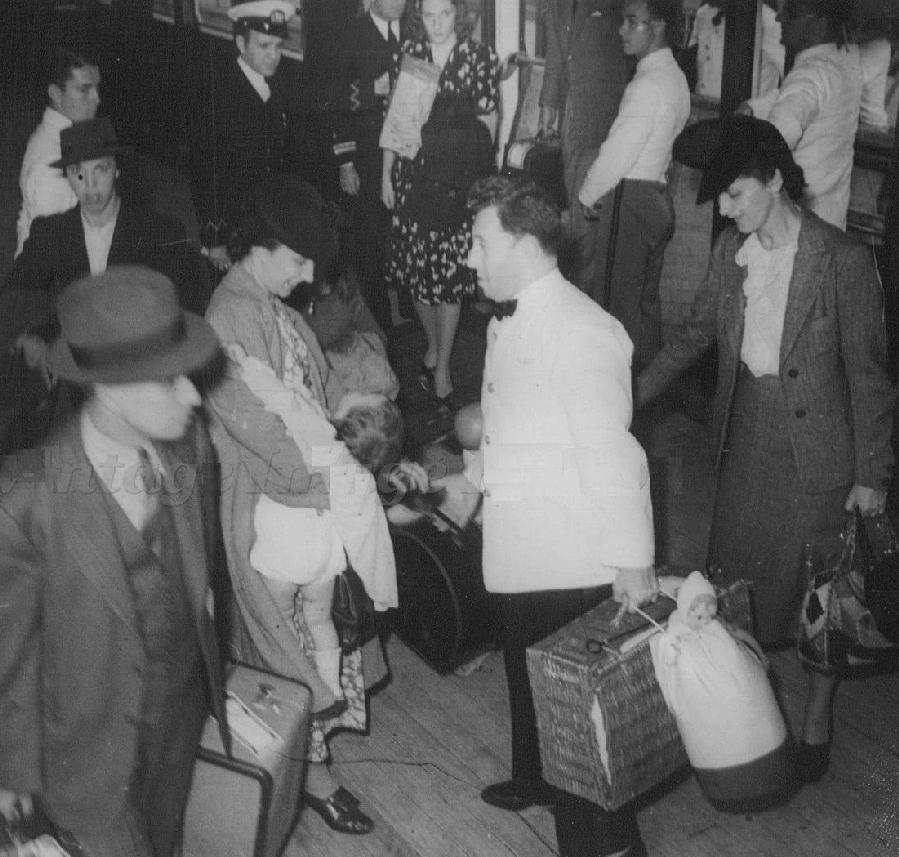
World War II Country Trends: Neutrals--Special Cases

Figure 1.--As in World War I, there were Americans in Europe when Hitler and Stalin launched World War II (September 1939). Mot wanted to get back home as soon as possible. And as World War I, America was at first neutral. Here Americans board a liner at Le Harve for the trip home to America (September 22, 1939). American neutrality became a central issue in World War II. Hitler wanted Americam to remain neutral long enough to complete his conquests in Europe.
|
|
Any discussion of neutrals has to include two special cases, the Soviet Union and the United States. They were potentially the two most powerful,countries in the world. Unlike most neutrals it eem imconceivablr that any one would attack either. The Soviets were neutral in that they did not go to war wih the Axis, at leat at first (1939). THe did, however go to war, attaking and annexing neigboring countries in whole or in part. The Allies did not declare war on the Soviets, although they considered doing so. In the ewnd, sanity prevented it. The Allies did not have the military capability of efeating the Germans, letbalone the Germans and Soviets combined. The Soviets also remained neutral in the Pacific War, at least until the NAZis were defeated in Europe. The Soviet Union might be coinsidered a neutral, but was in fact a valuable NAZI ally until attacked by the NAZIs. Theyfir nearly 2 years provided the NAZI war machine huge quantaties
of the critical raw materials the lacked, most importantly oil. The United States was also a neutral and despite strong neutrality laws was aiding Britain and France even before Hitler launched the War. Ironicall, the one ciuntry with the capability of waging global warfare, ws the country most determined to stay out ofvtheWar. The American people were strongly against entering another WEuropean War. As the war progressed, however. they accepted President Roosevelt 's determination to aid the Allies. Until Pearl Harbor (Devember 1941), A,erica was theireticall neutral, but a very unneutral neurtral. Aid to the Allies, especially Lend Lease kept Britain in the Wae. And the U.S. Navy launched an unclclared shooting war in the North Atlancic 3 months before Pearl Harbor.
The Soviet Union
The Soviet Union was never a neutral country during World War II at least in the sense of not being involved in the War. It was neutral in the sence iy was not at first at war with the Axis. In fact, it was Stalin in alliance with Hitler that launched the War by invading Poland (September 1939). It managed to do so without invoking the British and French treaty commitments to Poland. The British and French did not, however, declare war on the Soviet Union, only NAZI Germany. Stalin was much more calculatin than Hitler, only targeting small countries with little hope of foreign assistance. When Stalin invaded Finland (November 1939), the Allies (Britain and France) already at war with Germany, considered declaring war on the Soviet Union. They widely decided not to do so. So while the Soviets were conducting a series of aggresions in Eastern Europe, the country was neutral toward Britain and an ally of the Axis. But that did not mean that it was not a aggressor nation. Once Hitler invaded (June 1941), the Soviet Union became the lead country in the sruggle against NAZI Germany. At the same time while signing an agreement with the Polish Government in eile, the Soviets continued to wage a struggle against the Polish nation.
Of all the countries at the time of World War II, the United States was the only country with the indistrial and agricultura; potential to wage a global war effort. It was also the countru most determined to remain neutral and stay out of the war. President Roosevlt understood the dangers, but most Americans did not. And as a result, Congress passed neutrality laws designd to prevent the country from entering another war (1930s). This played into the hands of the totalitarian powers. Hitler and Stlin were intent on subgegating Europe before America could come into play as it did in World War I. Once Europe was in the hands of the totalitarians, the world balance pf power would be irrevoavly altered. And a the same time, Japam in the Pacifiv was intent on using the situation in Europe to carve out a bast new empire in the Southern Resource Zone. Thankfully for mankind, the British managed to survive the NAZI onslight and President Rooselvelt artfully slowly brought Americans around, if mot to enter the War, at least to become the Arsenal of Democracy to make sure Britain survived. Here he faced an extended fight with Isoltionist movement intent on keeping america out of the War.The sitation bgan to change when the ductaors has a falling out nd Hitler turned his war machine east and invaded the Soviet Union. This was aided e queston became whether Hitler could complete his conquest before America entered the War. America proved to be the least neutral of the neutral countries. After President Roosevelt not omly supplied Britain with Lend Lease material, but eventully ordered an undeclared naval war in the North Atlantic against NAZI U-boats. In the end, the question was answered by the Japanese who attavked the U.. Pacific Fleet at Pearl Harbor, beining the United States and its massive industrial power into the War.
CIH -- WW II

Navigate the CIH World warII Section:
[Return to Main World War II neutrality page ]
[Return to Main World War II country page ]
[Return to Main Dominican history page]
[About Us]
[Introduction]
[Biographies]
[Chronology]
[Climatology]
[Clothing]
[Disease and Health]
[Economics]
[Freedom]
[Geography]
[History]
[Human Nature]
[Law]
[Nationalism]
[Presidents]
[Religion]
[Royalty]
[Science]
[Social Class]
[Bibliographies]
[Contributions]
[FAQs]
[Glossaries]
[Images]
[Links]
[Registration]
[Tools]
[Children in History Home]
Created: 1:26 AM 3/28/2016
Last updated: 1:26 AM 3/28/2016



